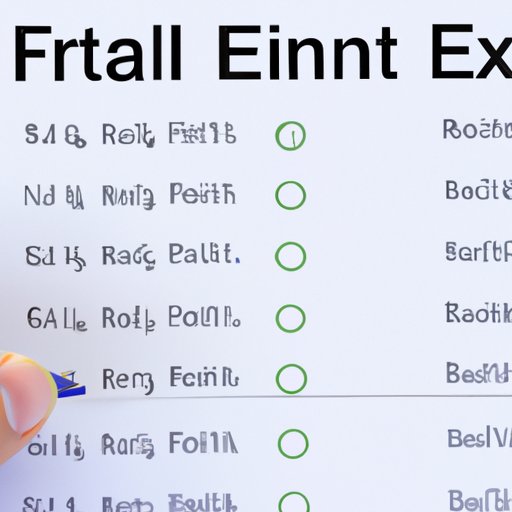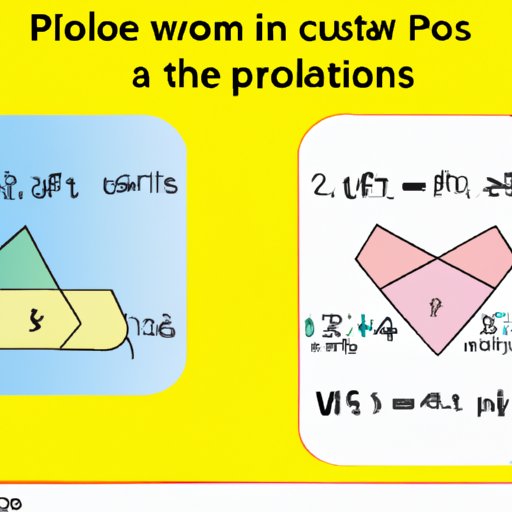Introduction
Word problems can be intimidating for many students. But with the right strategies and techniques, word problems can become much easier to tackle. This article will provide a step-by-step guide on how to solve word problems, including tips for breaking down the problem, using visual aids, providing examples, offering tips for common mistakes, and checking your answer.
Breakdown the Problem – Step-by-Step Guide
The first step in solving any word problem is to understand what it is asking. To do this, you need to break down the problem into its key pieces of information. Once you have identified the information, you can then translate it into an equation. Finally, you can use the equation to solve the problem.
Identify the Key Pieces of Information
In order to solve a word problem, you must first identify the information that will be needed to solve the problem. This could include numbers, variables, or other important data. For example, if you were asked to solve a problem about the cost of tickets to a concert, you would need to know the number of tickets purchased and the cost of each ticket. Knowing this information will allow you to solve the problem.
Translate the Problem into an Equation
Once you have identified the key pieces of information, you can then translate the problem into an equation. This equation should contain the variables and constants that you identified in the previous step. For example, if you were asked to solve a problem about the cost of tickets to a concert, your equation might look like this: Total Cost = Number of Tickets x Cost per Ticket.
Solve the Equation
Once you have translated the problem into an equation, you can then solve it. Depending on the complexity of the problem, this may involve using basic arithmetic operations such as addition, subtraction, multiplication, and division. It may also require more advanced skills such as factoring or using the quadratic formula. Regardless of the complexity, you can use the equation to find the solution to the problem.
Use Visual Aids to Illustrate the Problem
Using visual aids can be a great way to help you understand and solve a word problem. Visual aids, such as diagrams, graphs, and charts, can help you visualize the problem and make it easier to solve. For example, if you were asked to solve a problem about the cost of tickets to a concert, you might create a chart to show the number of tickets purchased and the cost of each ticket.
Diagrams
A diagram is a drawing that illustrates the relationships between different elements in a problem. Diagrams can be used to represent mathematical equations, as well as the relationships between different variables. For example, if you were asked to solve a problem about the cost of tickets to a concert, you might draw a diagram to show the relationship between the number of tickets purchased and the cost of each ticket.
Graphs
Graphs are another type of visual aid that can be used to illustrate a problem. Graphs can be used to show the relationships between different variables in a problem. For example, if you were asked to solve a problem about the cost of tickets to a concert, you might create a graph to show the relationship between the number of tickets purchased and the cost of each ticket.
Charts
Charts are another type of visual aid that can be used to illustrate a problem. Charts can be used to compare different variables in a problem. For example, if you were asked to solve a problem about the cost of tickets to a concert, you might create a chart to compare the number of tickets purchased and the cost of each ticket.

Demonstrate the Process with Examples
Providing examples can be a great way to demonstrate the process of solving a word problem. Examples can help students understand the steps involved in solving a problem and provide guidance when they are stuck. Examples can range from simple equations to complex equations. It is important to provide both types of examples so that students can learn how to approach different kinds of word problems.
Simple Equations
Simple equations are equations that involve basic arithmetic operations such as addition, subtraction, multiplication, and division. Examples of simple equations include: 5 + 6 = 11; 10 – 5 = 5; 3 x 4 = 12; and 20 ÷ 5 = 4. These equations can be used to demonstrate how to solve basic word problems.
Complex Equations
Complex equations are equations that involve more advanced mathematical operations such as factoring or using the quadratic formula. Examples of complex equations include: (x + y)2 = x2 + 2xy + y2; and x2 + 4x + 4 = 0. These equations can be used to demonstrate how to solve more complex word problems.
Offer Tips for Dealing with Common Mistakes
When solving word problems, it is important to be aware of common mistakes that can lead to incorrect solutions. Here are some tips for avoiding these mistakes:
Read the Problem Carefully
It is important to read the problem carefully and make sure you understand all of the information that it contains. This will help you avoid making mistakes when interpreting the question.
Double-Check Your Work
Once you have solved the problem, it is important to double-check your work to make sure that your solution is correct. This will help you avoid making mistakes when calculating the answer.
Don’t Forget to Include Units
When solving word problems, it is important to remember to include the appropriate units. For example, if you are solving a problem involving money, you should include the currency. This will help you avoid mistakes when interpreting the answer.

Provide Practice Problems and Solutions
Providing practice problems and solutions can be a great way to reinforce the concepts taught in the article. By providing sample problems and solutions, students can practice solving word problems and get feedback on their work. Sample problems can range from simple equations to complex equations.
Sample Problems
Here are some sample problems that can be used to practice solving word problems:
- If Jane bought three tickets to the concert, each costing $10, how much did she spend?
- If John has $50 and he spends $20 on snacks, how much does he have left?
- If Mary has 20 apples and she gives away half of them, how many apples does she have left?
Solutions to Sample Problems
Here are the solutions to the sample problems:
- Jane spent $30 ($10 x 3).
- John has $30 ($50 – $20).
- Mary has 10 apples (20 ÷ 2).

Show How to Check Your Final Answer
Once you have solved a problem, it is important to check your final answer to make sure it is correct. Here are some tips for checking your answer:
Double-Check Your Answer
Once you have solved the problem, it is important to double-check your answer to make sure you have calculated it correctly. This can be done by going through the steps again and verifying that each step is correct.
Compare Your Answer to the Solution Provided
If you are given a solution to the problem, it is important to compare your answer to the solution provided. If the two answers match, then you can be confident that your answer is correct. If they do not match, then you may need to revisit the problem and double-check your work.
Conclusion
Solving word problems can be a daunting task for many students. But with the right strategies and techniques, it can be much easier to tackle. This article provided a step-by-step guide on how to solve word problems, including tips for breaking down the problem, using visual aids, providing examples, offering tips for common mistakes, and checking your answer. With practice and patience, anyone can learn how to solve word problems.
(Note: Is this article not meeting your expectations? Do you have knowledge or insights to share? Unlock new opportunities and expand your reach by joining our authors team. Click Registration to join us and share your expertise with our readers.)
